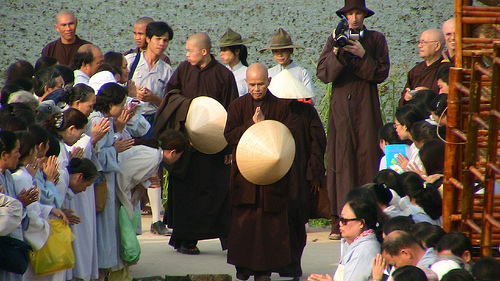Mindfulness is probably one of the most powerful stress-busters out there.
It’s also a phenomenal way to become fully engaged with life. Practiced and taught by teachers in traditions ranging from Vedic and Tantric to Buddhist and everything in between, it’s a versatile practice that we often gain access to through meditation, but can easily transfer to everyday living.
Here are a few of the tips I used to share with my Joy for Life corporate stress buster workshop participants—with a bonus one at the bottom recently shared by Yin yoga teacher Bernie Clark, taught by a teacher he’s been working with lately: Thich Nhat Hanh.
Essentially, they’re all based on the amazing, life changing premise that we are not our thoughts. If we practice distancing ourselves from our thoughts and our minds, we recognize our essential, calm and strong self below the surface drama. If you’d like more of these tips, there’s six more on my blog.
11 Mindfulness Tips for Meditation and Daily Living
YOUR SENSES
1. What can we see? Take a good look around you and notice what meets your eye. It’s nice to go beyond what we can observe and label, and notice more deeply. It’s not a sidewalk, it’s grays and browns and blacks and textures layered one upon the other.
2. What can we hear? For many of us, spring is here. Bird calls rise and fall. Lawn mowers charge the air. Windows are open—people are laughing inside. Sirens are blaring. Sound can become a mindfulness meditation, even it’s a sound we don’t usually like. We can practice simply noticing, and not reacting, letting the sound be what takes us out of our monkey mind.
3. What can we smell? That fresh-cut grass. The air coming in the window. What drifts in with it? Let yourself follow your nose.
4. What can we feel? If there’s a pen nearby, we can use that. What shapes, textures, and angles does it have? Or how about the sensation of your fingers hitting the keyboard? Let your intention and attention come there, and drop further away from your planning mind, racing ahead to the next thing on your to-do list.
5. What can we taste? I know a novelist who uses hard candies to help her stay out of planning what she’ll do when she’s wrapped up her writing for the day. David Romanelli’s Yoga + Chocolate workshops and yoga for foodies retreats work with this premise.
YOUR BREATH
6. Watch your breath. This is my favorite way to practice mindfulness, because our breath is always with us. And the switch-over to the calming systems that work with the parasympathetic nervous system happens almost as soon as we start to pay attention.
YOUR DAILY ROUTINE
7. Breakfast time. Really notice your food. What color is it? What textures does it have? What does it feel like in your mouth? Eating your breakfast can become a beautiful mini vacation from monkey mind.
8. Walking to work (or the bus). Here’s the perfect opportunity for a walking meditation. We can notice the sights, the sounds, the feeling on the bare skin of our hands, or the sensations of our feet touching and leaving the earth.,
9. On the bus/train. There are lots of ways to work this opportunity for peace. A few ideas: you can tune into one of your senses, close your eyes and notice simply notice your breath, or silently repeat a mantra.
10. Take time in the bathroom. Every day, no matter what we do for work, we have the opportunity to find peace—in the loo. It’s the perfect chance to take a moment to watch our breath, or our thoughts—noticing them and letting them go.
11. Thich Nhat Hanh cell phone meditation. This is one I recently learned from Yin yoga teacher Bernie Clark. Instead of grappling with our phone to answer it right away as soon as we hear the first ring, we turn it into an opportunity for peaceful contemplation. Ring 1: we pull out our cell phone. Ring 2: we notice who’s calling. Ring 3: We notice our breath. Ring 4: We answer.
Namaste,
Lindsey



Read 12 comments and reply